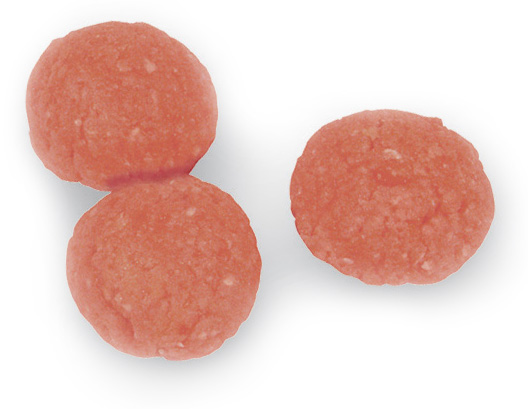There is a tenderness to meatballs made with veal that can’t be matched. Meatballs can be purchased ready-made or make your own with ground veal alone or blended with ground beef or pork.
MEATBALLS

Cooking Methods:

Pan-frying is best used for chops/medallions from the rib or loin sections, ground veal or veal meatballs, or for thin-cut veal cutlets or sliced liver (breaded or not breaded).
- Pat meat dry with paper towel. Season all over with salt and pepper to your taste. Bread cutlets with seasoned flour or bread crumbs if you like.
- Preheat oil in the skillet over medium-high heat.
Cutlets: use about a tablespoon (15 mL) of oil. NOTE: If cooking breaded cutlets, oil should come close to halfway up the sides of the cutlets.
Chops/medallions and ground veal: lightly oil the pan. - Add the meat to the skillet, careful not to overcrowd the pan.
Cutlets: cook 2 to 4 minutes per side for medium at most.
Ground veal: cook to 160°F (71°C).
Chops/medallions: Sear meat until golden brown on both sides. Reduce the heat to finish, turning twice or more until a digital instant-read thermometer inserted sideways into the meat, avoiding bone, reads 145°F (63°C) for medium-rare. Thick chops/medallions: after browning in an ovenproof skillet, transfer to a preheated 300°F (150°C) oven to finish.

Simmering/Braising/Stewing is used for stew cubes, cuts from the shoulder and shank or to poach veal meatballs or stuffed cutlets (roulade).
- Pat meat dry with paper towel. Season all over with salt and pepper to your taste. Heat a lightly-oiled deep skillet/sauté pan or Dutch oven/enamelled cast iron roaster over medium-high heat; add the meat and brown all over to a light colour, turning with tongs. Transfer to a plate/platter; set aside. NOTE: skip browning for recipes where the meat is to be poached (e.g. Blanquette or meatballs in sauce or soup).
- Reduce heat to medium and add a splash of oil if necessary; cook diced onions, celery or other seasoning vegetables until softened. (Optional: for thickening, add 1 tbsp (15 mL) of flour; cook stirring for 1 minute.) Add a splash of liquid (stock, wine or broth) and bring to a boil, stirring and scraping up and brown bits from the pan.
- Return meat and any accumulated juices to the pan. Add more liquid to just come half way up the meat. Cover and cook in preheated 325°F (160°C) oven or keep at a constant low simmer on stovetop, turning meat occasionally.
Stew cubes, chops, shank or roasts: cook until fork-tender, about 1¼ hours for stew cubes and chops, 1½ to 2 hours for shank, or 2 to 3 hours for roasts.
Meatballs and stuffed cutlets: cook until a digital instant-read thermometer reads 160°F/71°C when inserted into several meatballs/pieces, about 30 minutes, depending on the size. - Transfer meat and any vegetables to a bowl, platter or carving board; cover with foil and let rest 5 to 10 minutes.

Oven Roasting is best for Rack of Veal or other roasts from the loin or leg sections such as Sirloin, Loin and Round cuts. You can also roast (bake) meatballs and meat loaf. Sear roasts before cooking to help develop flavour and colour.
- Roasts: Pat meat dry with paper towel. Season all over to your taste. Place fat side up, or bones down on rack in sauté or shallow roasting pan. (NOTE: When roasting a Rack of Veal, there is no need for a rack in the pan.)
- Insert oven-safe meat thermometer into centre of the roast or meatloaf.
Roasts: Oven-sear in a preheated 450°F (230°C) oven for 10 minutes (or brown in a lightly oiled skillet on stovetop). Reduce heat to 275°F (135°C); roast uncovered, removing from the oven when 5°F (3°C) below 145°F/63°C for medium-rare, or 160°F/71°C for medium.
Meatballs or Meatloaf: Bake in a preheated 350°F (180°C) oven until cooked to 160°F (71°C). - Cover meat loosely with foil and let rest for 15 minutes (roasts and meat loaf), or 5 minutes (meatballs). Meanwhile, make a sauce for the roast if desired (See Step 4). Serve or carve roasts across the grain.
- To make a sauce for roasts: stir a splash of liquid (stock, wine or broth) into the roasting pan and bring to a boil, stirring and scraping up any brown bits from the pan. Strain the juices and thicken by cooking at a simmer until reduced, or stir in a mixture of equal parts cornstarch and cold water and heat, stirring, until thickened. Season to your taste.
